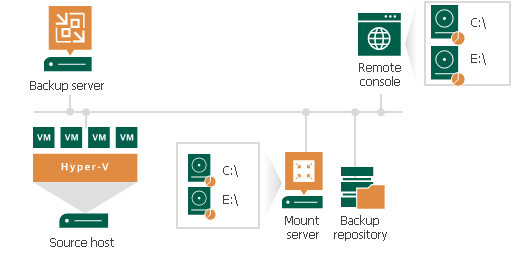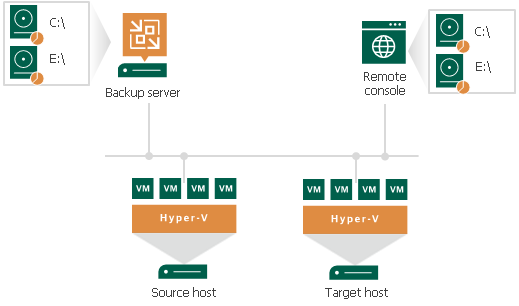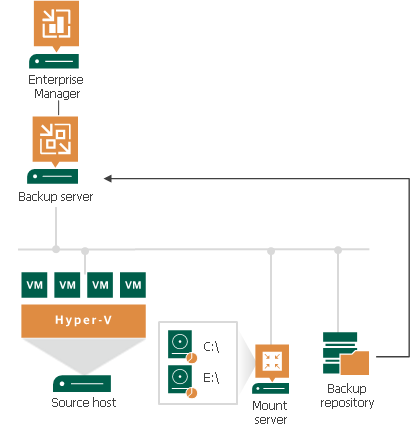 This is an archive version of the document. To get the most up-to-date information, see the current version.
This is an archive version of the document. To get the most up-to-date information, see the current version.Mount Points and Restore Scenarios
Veeam Backup & Replication creates mount points on different machines depending on a file-level restore scenario you use.
When you restore files from backups that reside in the backup repository, Veeam Backup & Replication creates a mount point on the following machines:
- Mount server associated with the backup repository on which the backup file resides. Veeam Backup & Replication uses this mount point when the restore process starts and allows you to browse the VM file system and restore files.
- Veeam Backup & Replication console. Veeam Backup & Replication uses this mount point only if you instruct Veeam Backup & Replication to mount VM disks there. For more information, see Open Files in Microsoft Windows Explorer.

Note |
Backup files on HPE StoreOnce are locked exclusively by a restore task. For this reason, Veeam Backup & Replication uses only one mount point on the backup server or Veeam Backup & Replication console machine for backups on HPE StoreOnce. |
When you restore files from a VM replica, Veeam Backup & Replication creates a mount point on the following machines:
- Backup server. Veeam Backup & Replication uses this mount point when the restore process starts and allows you to browse the VM file system and restore files.
- Veeam Backup & Replication console. Veeam Backup & Replication uses this mount point only if you instruct Veeam Backup & Replication to mount VM disks there. For more information, see Open Files in Microsoft Windows Explorer.

Restoring Files for Veeam Explorers
If you have launched file-level restore and then launch application items restore from the Veeam Backup browser, Veeam Backup & Replication uses additional restore points apart from the the mount points described in the subsections above:
- If you restore Microsoft Active Directory or Microsoft Exchange items, Veeam Backup & Replication creates an additional mount point on the Veeam Backup & Replication console. However, if during file-level restore the mount point was already created on a machine where the Veeam Backup & Replication console is installed, an additional point is not created.
- If you restore Microsoft SharePoint, Veeam Backup & Replication creates an additional mount point on a staging Microsoft SQL Server.
- If you restore Microsoft SQL Server items, Veeam Backup & Replication creates two additional mount points: one on a staging Microsoft SQL Server and the other one on the target VM to which you restore the application items.
- If you restore Oracle server items, Veeam Backup & Replication creates two additional mount points: one on a staging Oracle server and the other one on the target VM to which you restore the application items.
To create mount points on Linux and Windows machines, Veeam Backup & Replication uses different methods:
- To create a mount point on Microsoft Windows machines, Veeam Backup & Replication uses the iSCSI protocol. The remote machine or staging server acts as an iSCSI initiator. The machine on which the Veeam Explorer runs acts as an iSCSI target. The iSCSI mount point is non-persistent — it is created only for duration of the restore process.
- To create a mount point on Linux VMs (for Oracle running on Linux), Veeam Backup & Replication uses FUSE.
Restoring Files from Veeam Backup Enterprise Manager
When you restore files from Veeam Backup Enterprise Manager, Veeam Backup & Replication creates a mount point on the mount server associated with the backup repository on which the backup file resides. Veeam Backup & Replication uses this mount point when the restore process starts and allows you to browse the VM file system and then restore files.

Restoring Files from Nutanix AHV Snapshots
To learn how Veeam Backup & Replication performs guest OS file restore from backup snapshots, user snapshots and persistent disk snapshots created by AHV Backup Proxy and which mount points are used, see the Restoring Guest OS Files section of the Veeam Backup for Nutanix AHV User Guide.
Restoring Files from Amazon EC2 Instances
To perform a file-level restore for EC2 instances, Veeam Backup & Replication utilizes the functionality of AWS Plug-in for Veeam Backup & Replication. To learn more how file-level restore is performed, see the File-Level Restore section of the Veeam Backup for AWS User Guide.
Restoring Files from Microsoft Azure VMs
To perform a file-level restore for Microsoft Azure VMs, Veeam Backup & Replication utilizes the functionality of Microsoft Azure Plug-in for Veeam Backup & Replication. To learn how file-level restore is performed, see the File-Level Restore section of the Veeam Backup for Microsoft Azure User Guide.